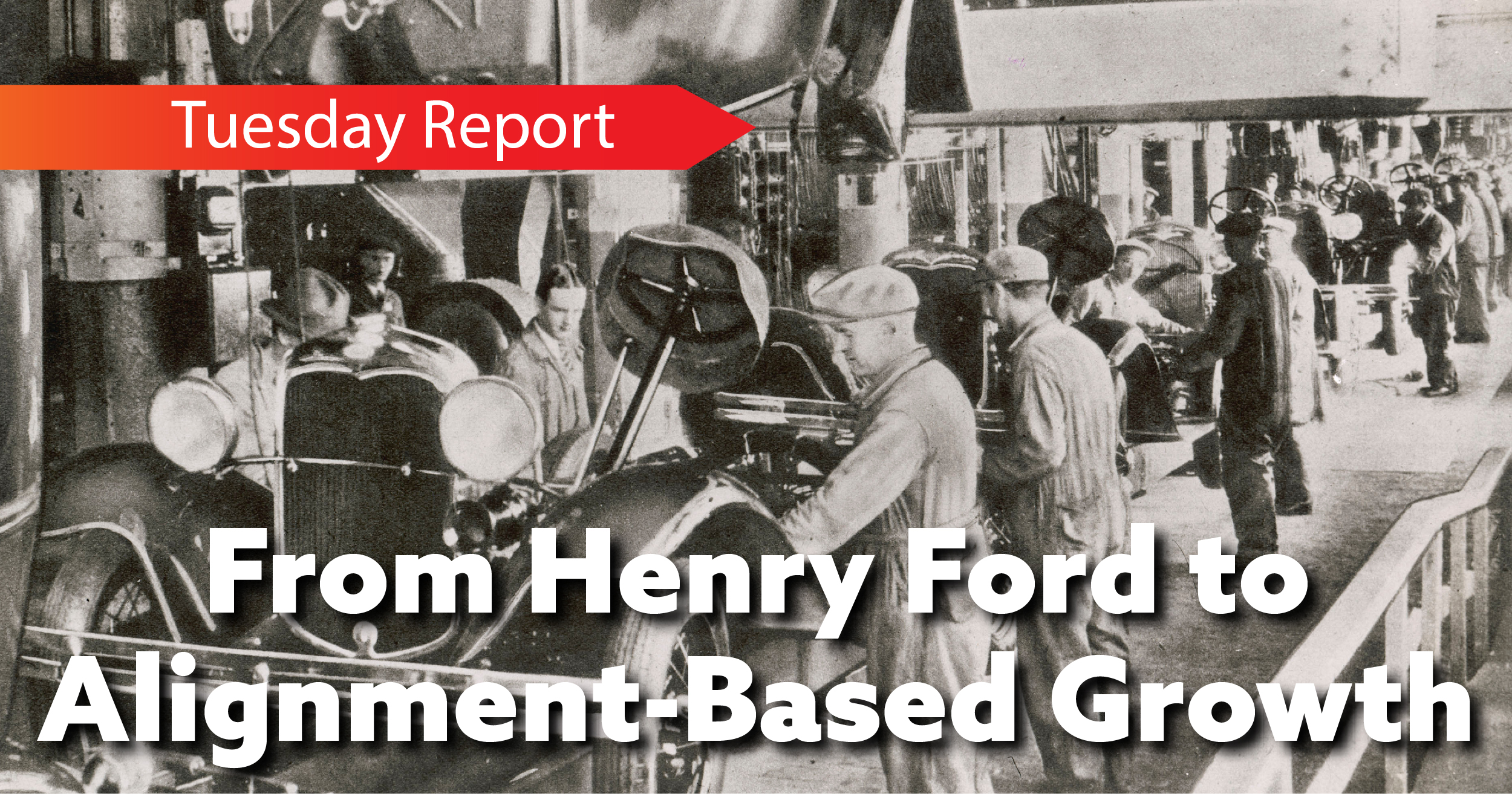How Alignment Based Growth
is Revolutionizing Organizations
Alignment is the key factor in the success of every human endeavor. An aligned team scales mountains, wins sports championships and defeats superior armies. Alignment holds families together, is the basis of new invention, and makes nations great.
Alignment as a word sums up achievement and success in organizations. It is the basis of growth and scaling.
Alignment-Based Growth (ABG) is emerging to the forefront with its power to connect people who might not have previously known each other to achieve what would have been impossible. ABG propels teams to succeed and is becoming part of the DNA of organizations.
Alignment does not happen by accident any more than sports teams win games without coaches or armies win battles without training. The average organization does not have a plan to achieve alignment and that is why so many fail that should have succeeded.
Organizations with amazing talent, superior technology, faultless process and enormous investment capital fail every day. Process and procedures are foundational to any company that succeeds, but without laser-focused and aligned leadership, organizations function as sub-optimized parts, striving to move forward but failing to arrive.
Organizations Today Can Be Technology-Driven Henry Ford Assembly Lines
In many ways, organizations are structured, automated, old-time assembly lines hooked up to new technology. Teams connect to the process and technology, but not to each other. They perform individual functions but do not move seamlessly as integrated teams toward the goal.
From the Assembly Line to Alignment-Based Growth
The assembly line that Henry Ford invented in 1913 was a modern miracle. It took people from the family farm, cobbler shop, or retail store and made them one productive unit. The assembly line placed them in a chair with parts moving down the line.
Each person had a single task to connect or modify what came to them at regular intervals. The assembly line reduced the amount of time it took to make a car from 12 hours to an hour and a half. Each person could focus on one task.
There was no need to understand how a car worked. They just needed to perform their individual task properly. They had no need to align, collaborate, or even know one another. The only place to connect was during a break or at lunch.
Today’s world demands employees who broadly create, individually innovate, and handle the disruptive events of unexpected change. Business needs workers who are individually capable of meeting those challenges and collectively aligned behind a clearly identified and understood imperative of the organization’s goals. In terms of the early assembly line, today anyone who “doesn’t understand how a car works” slows the process.
Unfortunately, Ford’s assembly line manufacturing methodologies are alive and well in organizations today. We still create separate functions done in sequence, create silos, and hierarchies. Even at the C-suite level, many leaders don’t fully understand the organization and all its cross-functional interconnections, just their own function. It’s not far off from Henry Ford and the assembly line.
IT systems in organizations have ratcheted up productivity, execute massively complex operations, and provide data to anyone in the organization anywhere on the planet at any time.
Yet people continue to be the puzzle. We recruit leaders who have been successful in organizations, the best available, at a cost of 25 to 30 percent of the first-year salary plus bonus per hire. The cost of hiring a junior level individual contributor is an average of $4,000. The average time a C-suite employee stays in their role is less than 4 years. Fast Company magazine reports that 60% of all managers fail at their jobs in the first 24 months. What’s not often pointed out is that most of these managers were actually successful somewhere else, which is why they were chosen as managers.
Why is the failure rate and turnover rate so high in organizations? Even when we know how costly it is to hire, why are we so often unsuccessful in seeing those hires succeed?
The reason is obvious. With the installation of a multi-million dollar technology system comes a highly trained IT staff that spends its days assuring that the systems work. If they don’t, someone comes immediately.
People hired at an organization are, for the most part, “self-installed.” They have to “find their way around” by doing what they’ve always done to see if it works. There is no people equivalent to an IT team. HR professionals are critically necessary to an organization. They answer questions and resolve issues. They provide training on critical subjects. They run the comp and benefits machine, recruit talent, onboard new hires, and manage employee issues.
All of that important work by HR professionals aside, when leaders begin to work together without the alignment process, they have to navigate the waters of unseen assumptions, like rocks under a fast-flowing river. The assumptions are that because everyone gathered together is a highly intelligent professional with a history of success, they are ready to work together effectively. We have seen over and over groups of carefully chosen professionals with outstanding educations and career tracks who brought huge bundles of long-held experiences and assumptions that were totally unaligned with each other. The differences were so strong and unseen, like the rocks under a flowing river, that doing their best to work together, their different approaches and experiences led them to failure.
As any investor will tell us, organizations succeed or fail based on their leadership teams. Yet they are adrift on rough waters without the alignment process.
And aligned teams do not happen by chance or accident. Armies that go into battle without a clearly defined mission and training will fail. A team of multi-million-dollar players will fail without alignment on a playbook.
When you think about it, how could leaders possibly believe an organization could become aligned without going through an alignment process?
But what is the alignment process? How does it work? The following are the five pillars of Alignment-Based Growth.
- Define—Define what we’re about and who we are. Defining “what we’re about” means clarifying the organizational imperative that every effort and initiative should align behind. Is it to capture 50% of market share? Retain 90% of our customers? Graduate 80% of our students? Whatever your imperative is: Define it. And communicate it.
Then define who is in the room. Most teams don’t have a comprehensive view of who they’re working with. Contrary to what many might think, the biography—how team members formed their approaches and views though their lives and careers—is one of the keys to aligning and building trust among people who have followed very different paths that can lead to conflicting management approaches.
How many times have you spent months working closely with colleagues on a team only to find out you didn’t really know them at all? Understanding their journey, education, work experiences, and their key management concepts and approaches is critically important and will enable you to find powerful commonalities and to manage differences.
Assessments are powerful tools to “define who is in the room.” Key assessments such as MBTI, FIRO-B, and others will equip the team to really know the substance and style of their leadership and how that aligns with the rest of the team. - Design – An aligned team is a designed team—not an accidentally emerging team. Teams most often come together without relationship rules, norms, and standards of conduct. These emerge as the team begins to work together. Dominant personalities emerge who control the narrative. Some are aggressive and others hang back, waiting to see what direction the team is moving.
Designing a team creates a template for team success by setting clear expectations. What are the key indicators for team success? How do we create communication flow? How do we find out about bad news as well as good? How transparent is the team? How will we handle conflict? What is the divide between frankness and rudeness? What are the codes of day-to-day conduct? How do the unsaid things get said? - Align – Alignment doesn’t happen by accident. It must be done in a safe place by professionals who are trained and experienced. It doesn’t take place on the fly. Alignment takes place when a team is committed to an imperative and invested in its success. It begins with leadership and connects with the rest of the organization, who have a clear understanding of what success is defined as—revenue, product release, an equity event. And that alignment connects all team cross-functionally behind the imperative and the expectations for performance and behavior. An aligned organization syncs up to the imperative from top to bottom and from side to side.
- Measure – Measurement is at the heart of ABG. We measure financial performance through our accounting departments. We measure team alignment around performance though our Delta 360-degree assessments of individuals, teams and the entire organization. The actual performance of team members in relationship to their OKRs and the evaluation of team members tells us to what extent the organization is aligned. It measures how well we execute on our mission, goals, and imperatives. It defines and measures our culture. Measurement tells us if alignment is on track.
- Accelerate. A “breakthrough” is a team achievement of the impossible. It is an accomplishment that is better than the team performance anyone had expected. It is the difference between Apple on the ropes in the 1990’s and global dominance with the invention of the iPhone. It is a financial achievement for the company and the team members. Breakthroughs come through the acceleration created by alignment.
The outcome of Alignment-Based Growth is organizational transformation. Too often we find organizations that have a tremendous talent base but are unable to leverage that expertise and experience to deliver exceptional results. They have potentially star players locked in a system that lacks alignment. The organization moves haltingly, a step forward and two steps backward. Alignment- Based Growth propels them to achieve the following:
- Increased leadership effectiveness, with fewer failures and less turn-over.
- Leadership that functions as a team understands how to score and win, united behind a laser-focused imperative. An aligned leadership meets and exceeds their goals and expectations.
- An employee base that is connected to leadership, knows where the organization is and how to get to the next stage. The employees feel included, motivated and informed.
- The organization experiences the energy and momentum to engage their employees and attract customers and clients.
Most organizations and leadership teams struggle with a feeling of unrealized potential, achieving results that–as good as they might be–are less than they should be, and a sense that progress is harder than it ought to be. Alignment-based Growth provides a five-step process to start enjoying the success your organization should be experiencing. It takes discipline and consistency….but it’s pretty darned straightforward. And if you want to talk it through, send me an email.






